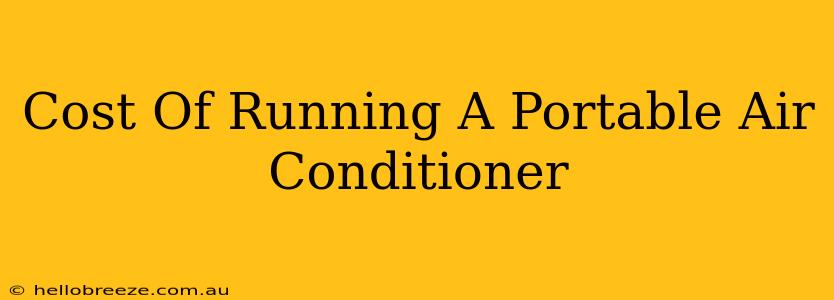Summer heat can be unbearable, making a portable air conditioner a tempting solution for staying cool. But before you rush out to buy one, it's crucial to understand the cost of running a portable air conditioner. This isn't just about the initial purchase price; the ongoing operational expenses can significantly impact your energy bill. This guide will break down the factors influencing the cost and help you make an informed decision.
Factors Affecting Portable AC Running Costs
Several factors contribute to the overall cost of running your portable air conditioner. Understanding these will help you predict and potentially minimize your expenses.
1. Energy Efficiency (BTU and EER):
The British Thermal Unit (BTU) rating indicates the cooling power of your AC unit. A higher BTU rating means more cooling capacity, but it also generally means higher energy consumption. The Energy Efficiency Ratio (EER) is a crucial metric. It represents the amount of cooling produced (in BTUs) per watt of electricity consumed. A higher EER signifies greater energy efficiency and lower running costs. Look for models with a high EER rating to save money.
2. Size of the Room:
Using a portable AC unit that's too small for the room will force it to work harder, consuming more energy and increasing your costs. Conversely, an oversized unit might be less efficient than a properly sized one. Choosing the right BTU capacity for the room size is vital for optimal performance and cost-effectiveness. Many manufacturers provide BTU capacity guidelines based on room square footage.
3. Climate and Usage:
The ambient temperature outside significantly affects how hard your portable AC needs to work. In extremely hot climates, the running costs will inevitably be higher. Your usage patterns also play a role. Leaving your portable AC running constantly will naturally increase electricity consumption compared to using it only when needed.
4. Electricity Prices:
Your local electricity rates are a direct factor in your overall costs. Higher electricity prices will translate directly to higher operating expenses for your portable air conditioner. Check your electricity bill for the current kilowatt-hour (kWh) rate.
5. Type of Portable AC:
Different types of portable air conditioners have varying levels of energy efficiency. Some may include features like inverter technology, which can help adjust cooling power based on the room temperature, potentially leading to energy savings. Always research and compare different models before making a purchase.
Calculating Your Estimated Running Costs
To estimate your monthly running cost, you'll need the following information:
- The portable AC's power consumption (in watts): This information is usually found on the unit's specifications or energy label.
- Your electricity price (in cents per kilowatt-hour): Check your electricity bill.
- Your daily usage (in hours): Estimate how many hours you plan to use the unit daily.
Formula: (Watts / 1000) x hours of daily use x electricity price per kWh x number of days in a month = monthly cost
Example: A 1000-watt portable AC used for 8 hours daily with an electricity price of 15 cents per kWh for 30 days would cost approximately $36 per month. (1000/1000) * 8 * 0.15 * 30 = $36
Note: This is a rough estimate. Actual costs may vary depending on the factors discussed above.
Tips for Reducing Portable AC Running Costs
Several strategies can help you minimize your portable AC's energy consumption and running costs:
- Improve insulation: Proper insulation in your home can reduce the amount of heat entering the room, minimizing the workload on your AC unit.
- Seal windows and doors: Prevent cool air from escaping by sealing any gaps around windows and doors.
- Use window coverings: Keep sunlight out during the day with curtains or blinds to reduce the heat entering the room.
- Set the thermostat higher: Even a small increase in the thermostat setting can save energy.
- Regular maintenance: Clean the filters regularly to ensure optimal airflow and efficiency.
Conclusion
Understanding the cost of running a portable air conditioner is essential for making a budget-friendly decision. While portable AC units offer convenient cooling, their running costs vary considerably based on several key factors. By considering these factors and employing energy-saving techniques, you can stay comfortable without breaking the bank. Remember to always compare models, prioritize energy efficiency, and choose the right size for your needs.

